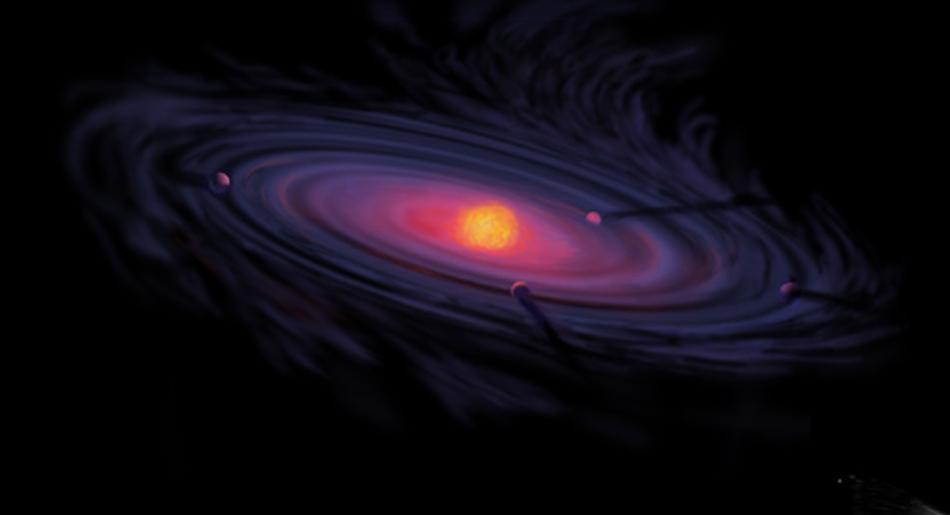Meteorite Study Suggests Early Solar System Was Donut-Shaped
A groundbreaking study is challenging our conventional understanding of the solar system’s original shape. It proposes a radical new theory that the early solar system was donut-shaped during its formative years.
This pioneering theory, derived from the analysis of iron meteorites, is set to revolutionize our comprehension of the early solar system and its evolution into the diverse array of planets and celestial bodies orbiting our sun.
Eight Planets Orbiting Around the Sun
Most people are well aware that the current model of our solar system suggests there are eight official planets on a similar plane rotating around our sun.

Source: Wikimedia
While we are all taught about this from a young age in school, researchers have suggested that it wasn’t always the case. But to unravel the mystery, we have to go back billions of years.
Our Solar System Billions of Years Ago
Approximately 4.5 billion years ago, the intricate process of our solar system’s formation began. A cloud comprised of gas and dust known as the solar nebula collapsed in on itself and led to the formation of our sun.

Source: Wikimedia
Some material left over from this event would eventually form the various planets and asteroids that currently comprise our solar system.
The Dartboard Solar System
During its formation and infancy, our solar system looked incredibly different. Researchers agreed it would have looked like a dartboard composed of concentric rings of celestial material orbiting around a star at the center.

Source: Wikimedia
This specific model of the early cosmic nursery within our solar system is known to researchers as a protoplanetary disk.
Concentric Rings of Celestial Material
Despite our inability to look back and observe how the solar system may have looked during its childhood years, researchers proposed the dartboard-shape theory as they observed this phenomenon elsewhere in our universe.

Source: Wikimedia
As they saw several of these concentric rings of celestial material, they theorized this must be what our solar system initially looked like.
New Solar System Theory Arises
Researchers at the University of California, Los Angeles, believe they have found evidence that suggests our solar system better resembles a donut than a dartboard, and shared this information in a new study.

Source: Freepik
The UCLA scientists reached their groundbreaking conclusion after meticulously studying iron meteorites from asteroids that formed during the universe’s infancy.
Researchers Study Meteorites
During the study, the researchers noticed that the asteroids contained a significant amount of refractory metals, including platinum and iridium.

Source: Wikimedia
These metals appear to have been plentiful in the outer rings of the early solar system, yet this puzzled the researchers as they assumed platinum and iridium should have formed much closer to the sun.
The Donut-Shaped Solar System
The results of this study led the researchers to rethink the dartboard-like model of the early solar system, theorizing these metals likely didn’t “jump” from ring to ring to embed themselves in the outer rim of the disk.

Source: Wikimedia
This observation led to the formation of a new theory about the shape of the solar system during its infancy, which suggests it looked more like a donut than a dartboard.
Problem Arsies With Their Theory
If the early solar system did, in fact, resemble a donut shape, this explains why the refractory metals ended up in the outer rims: they moved outwards as the disk expanded.

Source: Freepik
However, this observation did produce one problem. Due to the sun’s intense gravitational pull, the metals should have been pulled back towards the star in the several billion years that have elapsed since the solar system’s formation. However, they weren’t.
Researchers Attempt to Solve Their Problem
Planetary scientist Bidong Zhang, the first author of a new study, explained a possible solution for this problem in a statement.

Source: Wikimedia
“Once Jupiter formed, it very likely opened a physical gap that trapped the iridium and platinum metals in the outer disk and prevented them from falling into the sun,” he said.
Researchers Solve Their Problem
Zhang, a planetary scientist at the University of California, explained, “These metals were later incorporated into asteroids that formed in the outer disk.”

Source: Wikimedia
He continued, “This explains why meteorites formed in the outer disk — carbonaceous chondrites and carbonaceous-type iron meteorites — have much higher iridium and platinum contents than their inner-disk peers.”
Researchers Beleive in the Donut-Shaped Solar System
Researchers are now fairly certain that our solar system better resembles a donut-shaped protoplanetary disk than the older dartboard theory.

Source: Wikimedia
In its beginning, the donut comprised heavy metals before it eventually morphed into the multi-planetary system we know today.
